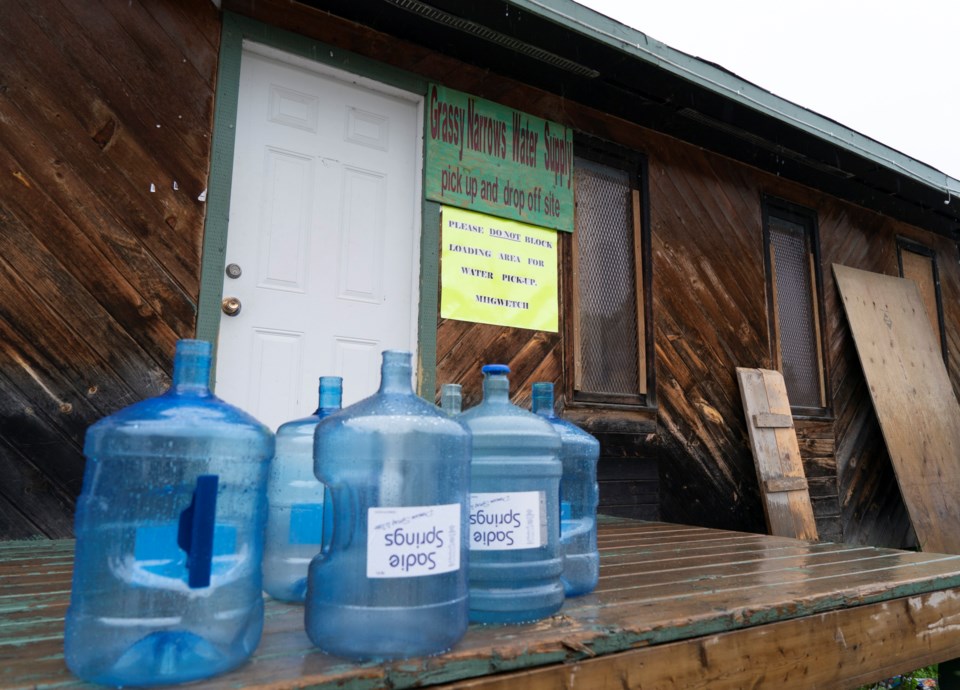Mercury poisoning in the English-Wabigoon river system is linked to high suicide rates in Grassy Narrows First Nation, a new study found.
It's the first time a peer-reviewed scientific study has made the connection between decades of exposure to dangerously high mercury levels and Grassy Narrow's suicide rate, which is significantly higher than other First Nations across the country.
In the 1960s, a chemical plant in Dryden, Ont. dumped mercury into the river system leading to mercury concentrations in fish almost "50 times the upper limit considered safe for human consumption," according to the study.
The fishing industry was a big part of the local economy and of residents' diets, so almost everyone was exposed to the dangerous neurotoxin. Though mercury levels declined into the 1980s, they're still much higher than in other Ontario rivers.
Grassy Narrows hadn't recorded a single suicide before the chemical plant started discharging mercury into the water in the 1960s. In an 11-month period in the late 1970s, 26 young people between the ages of 11 and 19 attempted suicide, according to the study.
The study reveals an "intergenerational impact of mercury poisoning on child and youth's emotions, behaviour and attempted suicide," wrote Donna Mergler, a professor emerita at the University of Quebec in Montreal who co-authored the study, in a presentation at Queen's Park on Wednesday.
Mergler and her coauthors used previously published community health and environmental monitoring data with a new study of 80 mothers and their 162 children.
The mothers and children portion was separated into two parts.
First, it looked at mothers with mental health issues stemming from mercury poisoning due to eating fish as children, as well as their mothers also eating fish while pregnant. The authors had access to data on mercury levels in umbilical cords, so were able to measure the concentration in mothers and grandmothers.
The second group looked at mothers whose fathers had been fishing guides in the poisoned waterways — effectively a proxy for mercury exposure when the researchers didn't have access to umbilical cords — and who themselves had eaten fish during their own pregnancies.
Around 80 per cent of Grassy Narrows households had at least one family member working as a fishing guide, the study said. During the tourist fishing season, 92 per cent of fishing guides reported bringing fish home to feed their families.
Previous studies attributed Grassy Narrows' high suicide rate "solely to social disruption caused by the disaster," this report said.
The findings released on Wednesday, however, clearly show a link between familial mercury exposure, mental health issues, and higher suicide rates, the authors argued.
"Children and youth whose grandfather was a fishing guide, whose mother ate more fish during pregnancy, or whose mother was exposed to more mercury in childhood, were more likely to have mental health issues or emotional and behavioural problems, which are connected to attempted suicide," reads a release.
The study also found the problem isn't limited to past familial exposure to mercury but also "ongoing due to current or recent exposure."
Despite mercury levels lowering since the initial discharging in the 1960s, it's still high enough to affect fetal development, the study said.
"We're very saddened by the report, but it also confirmed what we've been hearing all along," said Grassy Narrows Chief Rudy Turtle, speaking at Queen's Park on Wednesday.
Grassy Narrows needs more funding for specialized education and counselling, Turtle said, as well as direct compensation.
He also wants the provincial government to stop issuing mining permits in and around Grassy Narrows' territory.
"We don't want any more damage done to our land. We want to preserve our lands so our children can enjoy our land for many generations," he said.
Turtle joined other Indigenous leaders at Queen's Park earlier this year to protest what they called the provincial government's pro-mining agenda. The province, Turtle said, doesn't notify First Nations communities when a company makes a claim in their territory.
Ontario "should be approaching us and saying 'could we do this on your land?' but that never happens," he said in March.
Grassy Narrows is trying to figure out if and how they can clean the water so there's no more potential for poisoning, Turtle said, but that's still in the "study stage."
Removing the mercury "is a complex problem, but it has been done elsewhere and it can be done here," Mergler said.
A 2016 report suggested it's possible for the mercury to be removed but also said the current mercury levels mean the initial discharge could still be seeping into the water, or there could be new sources of contamination.
In 2021, Grassy Narrows inked an agreement with the federal government to build a mercury treatment centre to provide both in- and outpatient services to the community. In the time since it's been mired in cost overruns and delays, causing Turtle to question the federal government's commitment.
"The province has been working with Grassy Narrows to respond to concerns about the ongoing impact of mercury contamination in Grassy Narrows First Nation, including exploring options to provide health care and treatment services for Grassy Narrows community members through the development of a Mercury Care Home on reserve," said Flavia Mussio, a spokesperson for the Ministry of Indigenous Affairs.
"We appreciate Dr. Mergler’s report and will review the findings to assess how we can continue to support the youth of Grassy Narrows First Nation."
This story was updated after publication to include a comment from the Ministry of Indigenous Affairs
